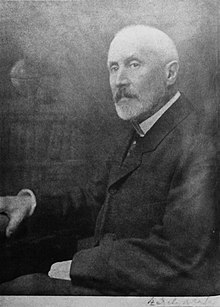瓦沙罗什瑙梅尼男爵厄特沃什·罗兰·阿戈什顿(匈牙利语:Báró vásárosnaményi Eötvös Loránd Ágoston,发音:[ˈloraːnd ˈøtvøʃ];1848年7月27日—1919年4月8日),又称罗兰·冯·厄特沃什男爵(Baron Roland von Eötvös[2]),中文常称厄缶[3],匈牙利王国内阁大臣、议会副议长、匈牙利科学院院长、匈牙利物理学家。在引力、表面张力、扭摆方面的贡献巨大。
匈牙利的厄特沃什·罗兰大学、厄特沃什·罗兰地理学协会和月球上的厄缶环形山均以厄特沃什的名字命名。小行星12301(Eötvös)也被以厄特沃什的名字命名。另外红铊矿的西文名Lorándite也是得名自厄特沃什·罗兰。
| 官衔 | ||
|---|---|---|
| 前任: Albin Csáky |
Minister of Religion and Education 1894–1895 |
继任: Gyula Wlassics |
| 文化职务 | ||
| 前任者: Ágoston Trefort |
President of the Hungarian Academy of Sciences 1889–1905 |
继任者: Albert Berzeviczy |
In addition to Eötvös Loránd University[4] and the Eötvös Loránd Institute of Geophysics in Hungary, the Eötvös crater on the Moon,[5] the asteroid 12301 Eötvös and the mineral lorándite also bear his name, as well as peak (Cime Eotvos) in the Dolomites.
Life
Born in 1848, the year of the Hungarian revolution, Eötvös was the son of the Baron József Eötvös de Vásárosnamény (1813–1871), a well-known poet, writer, and liberal politician, who was cabinet minister at the time, and played an important part in 19th century Hungarian intellectual and political life. His mother was the Hungarian noble lady Agnes Rosty de Barkócz (1825–1913), member of the illustrious noble family Rosty de Barkócz that originally hailed from the Vas county, and through this, he descended from the ancient medieval Hungarian noble Perneszy family, which died out in the 18th century. Loránd's uncle was Pál Rosty de Barkócz (1830–1874) was a Hungarian nobleman, photographer, explorer, who visited Texas, New Mexico, Mexico, Cuba and Venezuela between 1857 and 1859.
Loránd Eötvös first studied law, but soon switched to physics and went abroad to study in Heidelberg and Königsberg. After earning his doctorate, he became a university professor in Budapest and played a leading part in Hungarian science for almost half a century. He gained international recognition first by his innovative work on capillarity, then by his refined experimental methods and extensive field studies in gravity.
Eötvös is remembered today for his experimental work on gravity, in particular his study of the equivalence of gravitational and inertial mass (the so-called weak equivalence principle) and his study of the gravitational gradient on the Earth's surface. The weak equivalence principle plays a prominent role in relativity theory and the Eötvös experiment was cited by Albert Einstein in his 1916 paper The Foundation of the General Theory of Relativity. Measurements of the gravitational gradient are important in applied geophysics, such as the location of petroleum deposits. The CGS unit for gravitational gradient is named the eotvos in his honor.
From 1886 until his death, Loránd Eötvös researched and taught in the University of Budapest, which in 1950 was renamed after him (Eötvös Loránd University).
Eötvös is buried in the Kerepesi Cemetery in Budapest, Hungary.[6]
Torsion balance
A variation of the earlier invention, the torsion balance, the Eötvös pendulum, designed by Hungarian Baron Loránd Eötvös, is a sensitive instrument for measuring the density of underlying rock strata. The device measures not only the direction of force of gravity, but the change in the force of gravity's extent in the horizontal plane. It determines the distribution of masses in the Earth's crust. The Eötvös torsion balance, an important instrument of geodesy and geophysics throughout the whole world, studies the Earth's physical properties. It is used for mine exploration, and also in the search for minerals, such as oil, coal and ores. The Eötvös pendulum was never patented, but after the demonstration of its accuracy and numerous visits to Hungary from abroad, several instruments were exported worldwide, and the richest oilfields in the United States were discovered by using it. The Eötvös pendulum was used to prove the equivalence of the inertial mass and the gravitational mass accurately, as a response to the offer of a prize. This equivalence was used later by Albert Einstein in setting out the theory of general relativity.
This is how Eötvös describes his balance:
It was just a simple, straight stick that I used as instrument, specially loaded at both ends, enclosed into a metal sheath to protect it from the wind and temperature changes. Upon this stick every single mass, be it near or far, exerts a directing force; but the wire upon which it hangs resists, and whilst resisting it twists, with the degree of this twist showing us the exact magnitude of the forces acting upon the stick. This is a Coulomb balance, and that is all there is to it. It is simple, like the flute of Hamlet, you only have to know how to play on it, and just like the musician who can delight you with splendid variations, the physicist can, on this balance, with no less delight determine the finest variations of gravity. This way we can peer into such depth of the crust of the Earth, that neither our eyes, nor our longest drills could reach.[7][8]
One of Eötvös' assistants who later became a noted scientist was Radó von Kövesligethy.
Honors
To honor Eötvös, a postage stamp was issued by Hungary on 1 July 1932.[9] Another stamp was issued on 27 July 1948 to commemorate the centenary of the birth of the physicist.[10] Hungary issued a postage stamp on 31 January 1991.[11]
See also
- Eotvos, a unit of gravitational gradient
- List of geophysicists
- Lorándite, a mineral named after Loránd Eötvös
Template:Scientists whose names are used as non SI units Template:HungarianEducationMinisters
参考
延伸阅读
外部链接
Wikiwand in your browser!
Seamless Wikipedia browsing. On steroids.
Every time you click a link to Wikipedia, Wiktionary or Wikiquote in your browser's search results, it will show the modern Wikiwand interface.
Wikiwand extension is a five stars, simple, with minimum permission required to keep your browsing private, safe and transparent.

